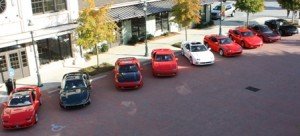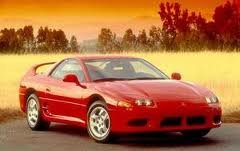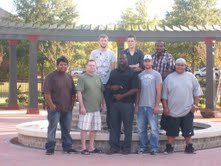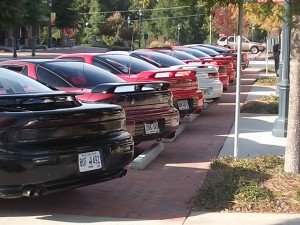Talking about a thing of beauty! Before I was invited out to GA3S Car Show and Photo Shoot, to be honest, I had never truly paid attention to the elegance the Mitsubishi 3000GT or the Dodge Stealth possessed or had in common. Guys and Dolls if you’re looking for something to brag about, I’d say find you a 3000GT or Stealth and watch heads turn!

 The Mitsubishi GTO is a sports car built by Japanese automaker Mitsubishi Motors between 1990 and 2001. In most export markets it was rebadged as a Mitsubishi 3000GT. It was also sold by Chrysler in North America as a Dodge Stealth captive import from the 1991 to 1996 model years with only minor detail/appearance differences. It took its name from the Galant GTO, a two-door hardtop coupé sold by the company in the early 1970s, which got its name from the Ferrari GTO, which means Gran Turismo Omologato.
The Mitsubishi GTO is a sports car built by Japanese automaker Mitsubishi Motors between 1990 and 2001. In most export markets it was rebadged as a Mitsubishi 3000GT. It was also sold by Chrysler in North America as a Dodge Stealth captive import from the 1991 to 1996 model years with only minor detail/appearance differences. It took its name from the Galant GTO, a two-door hardtop coupé sold by the company in the early 1970s, which got its name from the Ferrari GTO, which means Gran Turismo Omologato.
Following the successful showing of the Mitsubishi HSR and Mitsubishi HSX concept cars at the 1989 Tokyo Motor Show, Mitsubishi developed the new GTO as a technologically advanced 2+2 seater sports coupe to compete with the Honda NSX, Mazda RX-7, Nissan 300ZX, Skyline GT-R, and the Toyota Supra. They resurrected the GTO name, and the car went on to serve as Mitsubishi’s flagship for the remainder of the decade. However, despite the cachet of the badge at home, it was known as the Mitsubishi 3000GT outside Japan; the company was concerned that connoisseurs would object to the evocative nameplate from the highly regarded Ferrari 250 GTO and Pontiac GTO being used on a Japanese vehicle. However, regardless of its badge or eventual target market, every car was built on the same production line at Mitsubishi’s plant in Nagoya, Japan.
A Dodge Stealth was initially to be used as a pace car for the 1991 Indianapolis 500 race. The United Auto Workers (UAW), however, did not like the idea of a Japanese-manufactured car being a pace car for the race, and a prototype Dodge Viper was substituted.
1990–1993
The first generation model incorporated many of Mitsubishi’s contemporary performance-enhancing technologies, such as full time four-wheel drive, four-wheel steering, active aerodynamics featuring automatically adjusting front and rear spoilers, sport/tour exhaust modes and electronically controlled suspension (ECS). Visually, the cars featured pop-up headlights and noticeable “caps” on the hood to accommodate the ECS controllers at the top of the strut turrets.
 The President of the Eastside Georgia 3S (3S stands for 3000GT and Stealth) Car Club is Ronnie Hughes. Hughes drives the showcase, 1992 Mitsubishi 3000GT.
The President of the Eastside Georgia 3S (3S stands for 3000GT and Stealth) Car Club is Ronnie Hughes. Hughes drives the showcase, 1992 Mitsubishi 3000GT.
THE HEAT: So Ronnie, how many of these cars have you owned?
HUGHES: Just this one. I graduated in 1992 and in 1991 I first saw this car and had to have it but my parents couldn’t afford it. I kept my eye on this car until I was able to purchase it eight years ago. I’ve now owned this car for eight years and I’ve been through about three engines…(his wife says four but who’s really counting)…
THE HEAT: You’re the President of the Eastside Georgia 3S Car Club, but tell us a little about the organization.
HUGHES: Right, I’m the President of the Eastside Metro Atlanta Chapter. We currently have about thirty members and growing rapidly.That covers Lithonia, Stone Mountain, Conyers, Rockdale and all points east. The GA3000S Car Club is in every state. The Georgia Chapter is over one hundred members strong and the President of the Georgia Chapter is a young lady by name of Christy Pensinger. We guys and dolls get together to talk cars and offer support to those of us who are having mechanical problems, lending a hand to help get repairs done. We are often asked to be apart of parades, fund raisers, and other car shows in and around the area.
We guys and dolls get together to talk cars and offer support to those of us who are having mechanical problems, lending a hand to help get repairs done. We are often asked to be apart of parades, fund raisers, and other car shows in and around the area.
THE HEAT: So how does someone get to become a member or gather more information about the organization?
HUGHES: The 3000GT and the Dodge Stealth have car clubs all across the U.S. If someone is interested they can log on to www.georgia3s.org or they can log onto www.3sgto.org, nationwide.
THE HEAT: So what do people say when they see you drive up in this car?
HUGHES: They say, “Man, that’s a gorgeous car”…I smile and say “Thank You”…(as he smiles showing all his pearly whites)
1994–1996
Second generation models are identified by a revised front bumper to accommodate projector beam headlights and small, round projector fog lights. The caps on the hood were replaced with integrated blisters, and the side air vents and rear bumpers were modified. The interior was redesigned with dual air bags, a new audio system, and revised air conditioning refrigerant. The engines in the twin-turbo models received a slight boost in torque from 307 lb·ft (416 N·m) to 315 lb·ft (427 N·m). To complement this, the VR-4 now included a six-speed Getrag manual transmission. Bigger wheel/tire combinations were provided beginning in 1995. The base and SL model received 16″ wheels in silver or chrome with 225/55 tires, while the VR4 now had 18″ chrome wheels with 245/40 tires (the Spyder had the standard 17” with higher profile tires from 1994 to handle the additional 400 lb (180 kg)).
THE HEAT: So what’s happening Nick, tell us a little about what you’re driving.
JACOBS: I’m Nicholas Jacobs and I’m driving a 1995 VR4 Twin Turbo 3000
THE HEAT: How long have you owned your car Nick?
JACOBS: I’ve owned my car for three years.
THE HEAT: How long have you been in the car club?
JACOBS: I’ve been in the car club for two years.
THE HEAT: So what do people say when they see you driving by?
JACOBS: The enthusiasts really enjoy the look. It’s a bad car. What can I say?
THE HEAT: So how many tickets have you gotten in this car?
JACOBS: I better not say…(He smiles and giggles hard)
As the price of the cars increased, many of the “gadgets” on the car were discontinued. The tunable exhaust was phased out after model year 1994, the ECS disappeared after the 1995 model year, and the active aerodynamics disappeared after 1996. Finally, Chrysler ceased sales of the Dodge Stealth captive import, and for the remainder of its life only Mitsubishi-badged versions were available.
In 1995 and 1996, special edition retractable hardtop convertible models of the 3000GT SL and VR-4 were sold in the USA. Customized by ASC in California, these cars had retractable hardtops which could be opened or closed at the touch of a button. It was the first of its kind in America since the 1957–59 Ford Skyliner, and although it was abandoned after two years because of slow sales (1618 units), it presaged a market which would eventually mature the following year with the Mercedes SLK.
 1997–2001
1997–2001
The SOHC engine, previously only available in the base model Stealth, was added to the Mitsubishi range after the Dodge version was discontinued. Slower sales in the American sports car market led to a planned facelift for 1997 being abandoned in favor of minor cosmetic adjustments, including a new front bumper and hoop wing. In 1999 the car received a partial exterior makeover, including new front bumper, headlamps, turn signals, sail panels, and a large wing for the 1999 VR-4 to distinguish it from previous models. Production for the Japanese domestic market finally ceased in 2000, with the last two cars sold the following year.
The members present at this years 2nd Annual Eastside GA3S photo shoot were:
President Ronnie Hughes…….Wine Colored 1992 3000GT
Nicholas “Nick” Jacobs……….Pearl White 1995 VR4 Twin Turbo
Paul Pinzino……………………Red 1994 3000GT 6G74 Engine
Chuck Dawson………………..Red 3000GTSL
Ian Paulmer……………………Green 92 Stealth
Miguel Amador………………..Red 1992 3000
Lewis Amador…………………Black 1993 Stealth RT Twin Turbo
Jeff Morris…………………….Red 1993 3000VR4 Twin Turbo
DJ Lonnie Long……………….Driver
I don’t know about you but I’m already in the for sale ads looking for a 3000GT or Stealth. I think I’m leaning more for a 3000GT, sorry Stealth. The car is great on the eyes and it’s even better on the road.
Hey Ronnie…got room for one more! A’heehee!
Much Love! One Love!
Feel “The HEAT”



